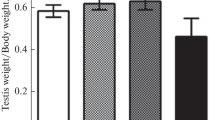Abstract
IN the immature female rat, the ability to secrete the gonadotrophins luteinising hormone (LH) and follicle-stimulating hormone (FSH) in response to a single injection of oestradiol or of progesterone first appears about day 28 of life1,2. Younger animals respond to these hormonal stimuli with an increased release of gonadotrophins only if they have been primed with an injection of oestrogen 3 or more days earlier, and it is assumed that the priming steroid promotes the functional maturation of a positive (stimulatory) feedback system3 by an unknown mechanism. Alternatively, electrolytic lesions in the area of the basal hypothalamus of 23-d-old rats induce precocious sexual maturation leading to pubertal ovulation within 4 or 5 d (ref. 4). The lesion site is rich in luteinising hormone releasing hormone5, and it seems likely that the discharge of this polypeptide triggers the rapid and sustained increase in the production of ovarian steroids, particularly of oestrogen, observed during this period4. We report here that the increase of endogenous steroid in response to a brain stimulus can prime the positive feedback system in a manner closely related to the effect of exogenous oestrogen. This suggests that brain lesions advance the process of sexual maturation through the precocious establishment of a positive feedback loop.
Similar content being viewed by others
References
Caligaris, L., Astrada, J. J., and Taleisnik, S., J. Endocr., 55, 97–103 (1972).
Caligaris, L., Astrada, J. J., and Taleisnik, S., J. Endocr., 58, 547–554 (1973).
Steele, R. E., and Weisz, J., Endocrinology, 95, 513–520 (1974).
Ruf, K. B., YoungLai, E. V., and Holmes, M. J., Brain Res., 78, 437–446 (1974).
Palkovits, M., Arimura, A., Brownstein, M., Schally, A. V., and Saavedra, J. M., Endocrinology, 95, 554–558 (1974).
Davidson, J. M., in The Control of the Onset of Puberty (edit. by Grumbach, M. M., Grave, G. D., and Mayer, F. E.), 79–103 (Wiley, New York, 1974).
Donovan, B. T., and van der Werff ten Bosch, J. J., Physiology of Puberty (Williams and Wilkins, Baltimore, 1965).
Stumpf, W. E., Science, 162, 1001–1003 (1968).
Sar, M., and Stumpf, W. E., Science, 183, 1266–1268 (1973).
Ramirez, V. D., and Sawyer, C. H., Endocrinology, 76, 1158–1168 (1965).
Wilson, C. A., Horth, C. E., Endersby, C. A., and McDonald, P. G., J. Endocr., 60, 293–304 (1974).
Bronson, F. H., Endocrinology, 96, 511–514 (1975).
Author information
Authors and Affiliations
Rights and permissions
About this article
Cite this article
RUF, K., WILKINSON, M. & DE ZIEGLER, D. Brain lesions and precocious puberty in rats. Nature 257, 404–405 (1975). https://doi.org/10.1038/257404a0
Received:
Accepted:
Issue Date:
DOI: https://doi.org/10.1038/257404a0
- Springer Nature Limited





